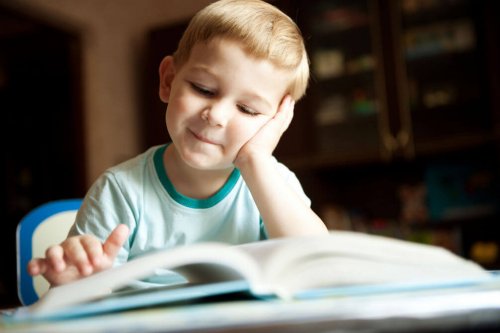What's The Best Age for a Child to Start to Learn to Read?

What is the ideal age to start to learn to read? This question depends on each child’s particular abilities and maturity. Rushing children or pressuring them can be counterproductive and can even generate frustration.
The first thing: to know how to talk
The first requirement is that children have a basic command of language. This means that that they should know how to speak and understand what they hear.
Maturity is another aspect that should be considered, as children may not be able to assimilate this type of learning. Children need adequate psychological and cognitive development in order to begin this process of learning how to read.
There is a considerable gap between when children make their first sounds until when they start to speak clearly. This time will vary according to each child. Understanding written language requires high intellectual development and the child must be able to cope.
What is the minimum age to learn to read?
From the age of three to five, children have their first contact with written language. Tracing activities, games, drawings, knowing some letters or words – like names – can awaken the child’s interest in written language. At this age, it’s more than enough to simply recognize some signs and letters and to start to use a pencil.
Under normal circumstances, we should start to involve children in reading and writing activities at six years of age. Depending on their abilities at that stage, they may advance slowly or quickly.
The issues to consider for children to start to learn to read are:
- Motor coordination
- Visual organization
- Broad vocabulary
- Ability to listen
- Interest to learn

Is early stimulation counterproductive?
In today’s world, everything is going faster and faster, and children are advancing quicker as well. This is an era of constant stimulation. However, advancing certain processes can actually be counterproductive.
This can cause frustration in children, and trigger problems with understanding and expression that won’t appear until the age of 12.
“Adequate psychological and cognitive development is required in order to learn to read”
Moving from oral language to writing implies a considerable leap. Children are used to dealing with distinguishing certain sounds.
However, the leap to distinguishing one letter from another is quite different. At first, this can be confusing and far too abstract for little ones. As a consequence, advancing the processes too quickly could demotivate them.
The start of graphomotor skills
Both the traditional method and the constructivism theory say that the start of graphomotor activity starts at around 3 years of age. At primary school this will progress to the first attempts at distinguishing words and trying to write them.
Motivation is fundamental
Motivation is the parents and teachers’ responsibility in order to meet the required objectives. The important thing is that the child doesn’t feel pressured.
At around five years of age, the child will be able to adapt to routines, develop social skills, play and work with other children. Everything can be achieved, but we should do it at his or her pace.
Imitation is a common practice in children. They may be interested in reading or writing when they see adults doing it. They may be able to recognize and try to reproduce the letters of their name, or even try to write a letter to grandparents or a friend.
So, then, what is the recommended age to start to learn to read? The answer to this question will depend on the maturity of each child.
How to stimulate their creativity
There are, however, things we can do to help children start learning at an earlier age. With these simple activities we can stimulate their creativity:
- Reading good stories
- Showing them letters or games related to words
- Showing them books with different textures or games
- Giving them drawing and writing materials to practice with
“Imitation is a common practice in children. They may get interested in reading or writing when they see adults doing it “
The objective in all of this is for children to have fun. In this way, they’ll automatically become interested in the wonderful world of reading, something that will stay with them for the rest of their lives.

Children who express and pronounce words well, and understand what they’re saying, are ready to learn to read. If they understand concepts such as down, up, before, after, left or right, then starting to read will be easier for them.
When they’re able to make pencil strokes with their hand, controlling the pressure on the pencil, then they’ll soon start reading and writing. We can then teach them letters and move on to sentences, using all sorts of activities to encourage their imagination and creativity.
The important thing is to let your children learn at their own pace, and help them continually without any sort of undue pressure.
What is the ideal age to start to learn to read? This question depends on each child’s particular abilities and maturity. Rushing children or pressuring them can be counterproductive and can even generate frustration.
The first thing: to know how to talk
The first requirement is that children have a basic command of language. This means that that they should know how to speak and understand what they hear.
Maturity is another aspect that should be considered, as children may not be able to assimilate this type of learning. Children need adequate psychological and cognitive development in order to begin this process of learning how to read.
There is a considerable gap between when children make their first sounds until when they start to speak clearly. This time will vary according to each child. Understanding written language requires high intellectual development and the child must be able to cope.
What is the minimum age to learn to read?
From the age of three to five, children have their first contact with written language. Tracing activities, games, drawings, knowing some letters or words – like names – can awaken the child’s interest in written language. At this age, it’s more than enough to simply recognize some signs and letters and to start to use a pencil.
Under normal circumstances, we should start to involve children in reading and writing activities at six years of age. Depending on their abilities at that stage, they may advance slowly or quickly.
The issues to consider for children to start to learn to read are:
- Motor coordination
- Visual organization
- Broad vocabulary
- Ability to listen
- Interest to learn

Is early stimulation counterproductive?
In today’s world, everything is going faster and faster, and children are advancing quicker as well. This is an era of constant stimulation. However, advancing certain processes can actually be counterproductive.
This can cause frustration in children, and trigger problems with understanding and expression that won’t appear until the age of 12.
“Adequate psychological and cognitive development is required in order to learn to read”
Moving from oral language to writing implies a considerable leap. Children are used to dealing with distinguishing certain sounds.
However, the leap to distinguishing one letter from another is quite different. At first, this can be confusing and far too abstract for little ones. As a consequence, advancing the processes too quickly could demotivate them.
The start of graphomotor skills
Both the traditional method and the constructivism theory say that the start of graphomotor activity starts at around 3 years of age. At primary school this will progress to the first attempts at distinguishing words and trying to write them.
Motivation is fundamental
Motivation is the parents and teachers’ responsibility in order to meet the required objectives. The important thing is that the child doesn’t feel pressured.
At around five years of age, the child will be able to adapt to routines, develop social skills, play and work with other children. Everything can be achieved, but we should do it at his or her pace.
Imitation is a common practice in children. They may be interested in reading or writing when they see adults doing it. They may be able to recognize and try to reproduce the letters of their name, or even try to write a letter to grandparents or a friend.
So, then, what is the recommended age to start to learn to read? The answer to this question will depend on the maturity of each child.
How to stimulate their creativity
There are, however, things we can do to help children start learning at an earlier age. With these simple activities we can stimulate their creativity:
- Reading good stories
- Showing them letters or games related to words
- Showing them books with different textures or games
- Giving them drawing and writing materials to practice with
“Imitation is a common practice in children. They may get interested in reading or writing when they see adults doing it “
The objective in all of this is for children to have fun. In this way, they’ll automatically become interested in the wonderful world of reading, something that will stay with them for the rest of their lives.

Children who express and pronounce words well, and understand what they’re saying, are ready to learn to read. If they understand concepts such as down, up, before, after, left or right, then starting to read will be easier for them.
When they’re able to make pencil strokes with their hand, controlling the pressure on the pencil, then they’ll soon start reading and writing. We can then teach them letters and move on to sentences, using all sorts of activities to encourage their imagination and creativity.
The important thing is to let your children learn at their own pace, and help them continually without any sort of undue pressure.
All cited sources were thoroughly reviewed by our team to ensure their quality, reliability, currency, and validity. The bibliography of this article was considered reliable and of academic or scientific accuracy.
- Aguirre, R. (2004). La lectura y la escritura en la escuela. En J. Peña González y S. Serrano de Moreno (Comps.), La lectura y la escritura en el siglo XXI (pp. 70-79). Mérida. Venezuela: CDCHT – ULA.
- Cassany, D. (1996). Describir el escribir. Cómo se aprende a escribir. Barcelona, España: Pai-dós Ibérica S. A.
- Fons, M. (2001). Enseñar a leer y a escribir. En Didáctica de la lengua en la educación infantil. Monserrat, Bigas y Monserrat Correig (Edits.) pp. 179-212. Madrid: SÍNTESIS, S. A.
- Villalobos, J. (2006). La lectura y la escritura como herramientas para el desarrollo del cono-cimiento y aprendizaje. En J. Peña González y S. Serrano de Moreno (Comps.), La lectura y la escritura. Teoría y práctica (pp. 33-58). Mérida. Venezuela: Consejo de Desarrollo Científico Humanístico y Tecnológico y Consejo de Estudios de Postgrado Universidad de Los Andes.
- Vygotsky, L. (1979). El desarrollo de los procesos psicológicos superiores. Barcelona: Grijalbo.
This text is provided for informational purposes only and does not replace consultation with a professional. If in doubt, consult your specialist.








